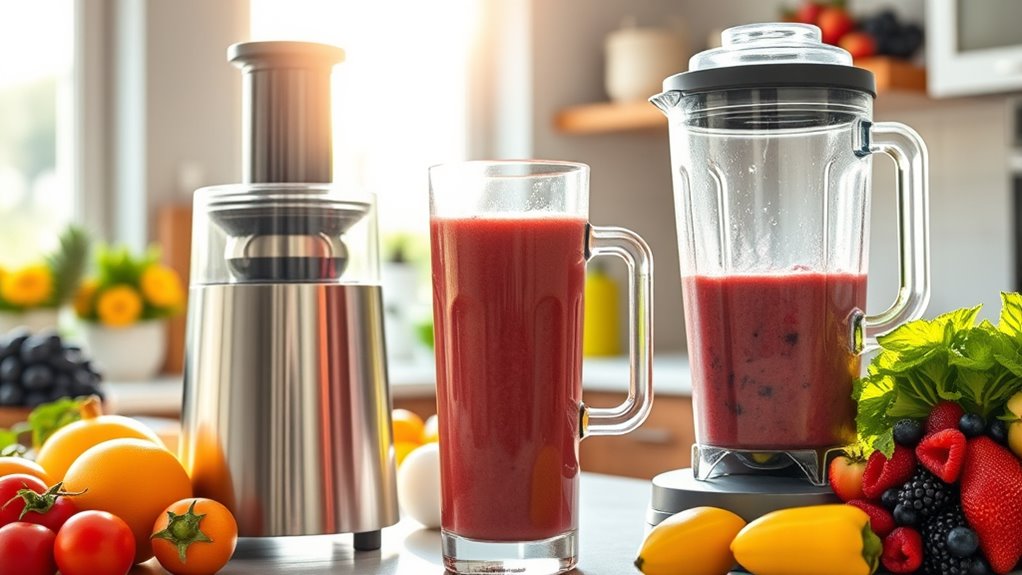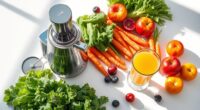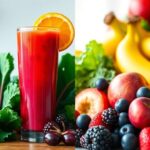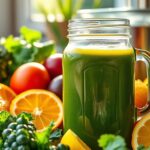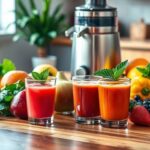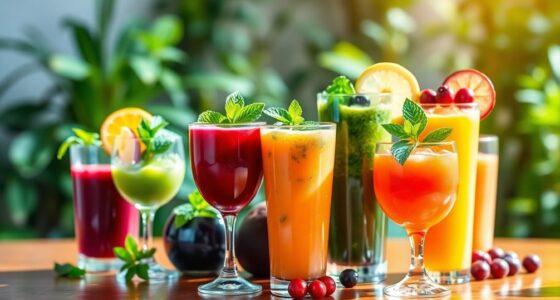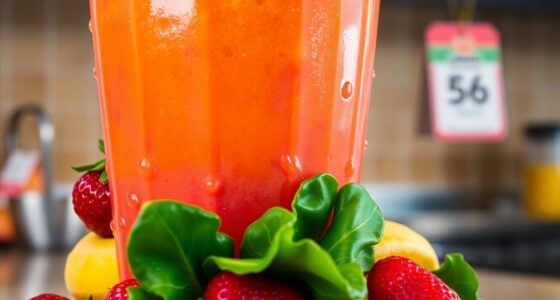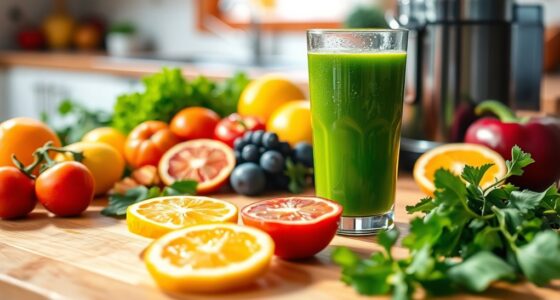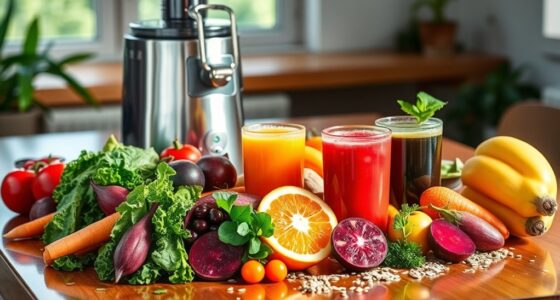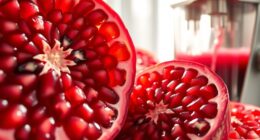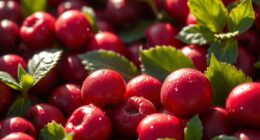Juicing and blending each offer unique health benefits that can enhance your wellness journey. Juicing gives you concentrated nutrients for quick absorption, while blending retains fiber for improved digestion and satiety. Juicing aids in detoxification but may spike blood sugar levels, whereas blending promotes steady energy release and stabilization. Understanding these differences can help you make informed choices for your health. Stick around to discover how each method can fit into your lifestyle!
Key Takeaways
- Juicing provides quick nutrient absorption by extracting vitamins and minerals, while blending retains fiber for improved digestion and satiety.
- Juicing may spike blood sugar levels due to the lack of fiber, whereas blending promotes steady energy release and stable blood sugar.
- Fresh juices can last up to 3 days in the refrigerator, while blended smoothies are best consumed immediately for optimal nutrient retention.
- Masticating juicers preserve enzymes and nutrients, while high-quality blenders like Vitamix effectively blend whole fruits and vegetables for optimal health benefits.
- Choosing between juicing and blending depends on personal health goals, with juicing for rapid nutrients and blending for overall digestive health.
The Essence of Juicing

When you think about juicing, consider it a powerful way to maximize your nutrient intake. By extracting water and nutrients from fruits and vegetables, juicing makes these crucial elements readily available for absorption while discarding insoluble fiber.
This process allows you to consume large quantities of produce in a single serving, greatly boosting your nutrient intake. Freshly squeezed vegetable juices are particularly nutrient-dense, aiding in detoxification and hydration.
If you have a sensitive digestive system or are recovering from an illness, juicing simplifies digestion. However, be cautious—juicing can lead to rapid spikes in blood sugar levels, especially with fruit juices. If you’re monitoring your blood sugar, it’s essential to choose your ingredients wisely. Additionally, incorporating green juice into your routine can provide high levels of vitamins while promoting immune health.
Benefits of Juicing

Juicing offers a multitude of benefits, especially for those looking to enhance their health and wellness. By extracting concentrated vitamins and minerals from fruits and vegetables, juicing allows for quick nutrient absorption, boosting your energy levels and supporting hydration.
Fresh vegetable juices are particularly nutrient-rich, aiding in detoxification and potentially speeding up recovery from illnesses. If you struggle with digestive issues, juicing simplifies digestion by removing insoluble fiber, making it easier for nutrients to enter your system.
Many people undergoing treatments, like chemotherapy, find juicing helpful for pain relief and promoting healing. Just remember, while fruit juices can spike blood sugar levels, incorporating more vegetable juices can provide a healthier alternative. Additionally, regular consumption of fresh vegetable juices can be an effective way to support overall health and well-being.
The Blending Phenomenon
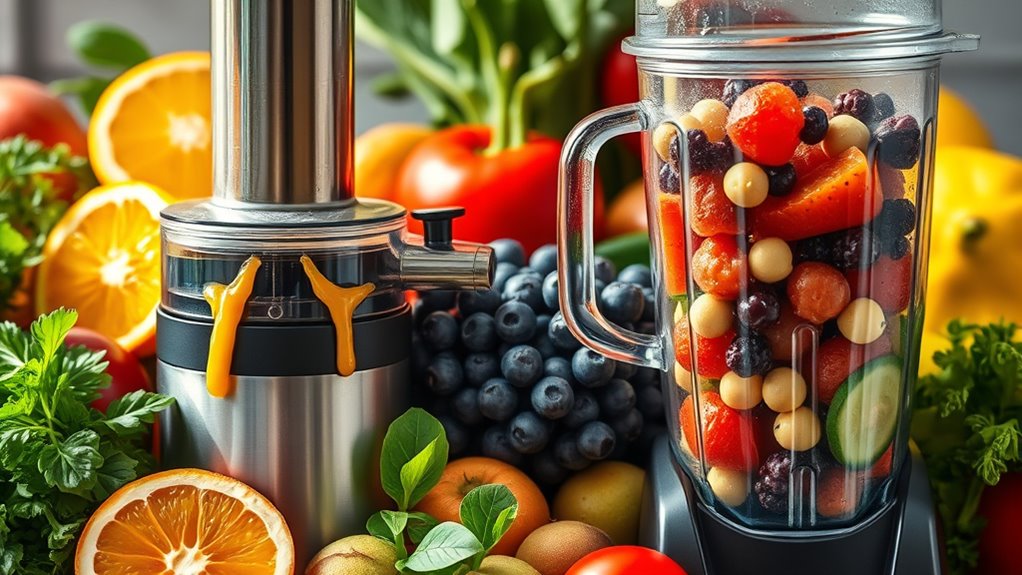
Blending has rapidly gained popularity as a convenient and nutritious way to enjoy fruits and vegetables. Unlike juicing, blending retains the fiber and nutrients, creating a thicker texture that helps you feel fuller and regulates blood sugar levels.
Smoothies can easily serve as meal substitutes, allowing you to incorporate a wider variety of nutrient-dense ingredients like nuts, seeds, or protein powders. This versatility in recipes means you can mix and match flavors to suit your taste.
Smoothies offer endless possibilities for meal substitutes, blending in nutrient-rich ingredients to cater to your unique taste preferences.
Plus, the blending process is generally quicker and more suitable for busy lifestyles. By promoting slower digestion, blending provides a steady release of energy and nutrients, making it an ideal choice for on-the-go meals. Additionally, juice cleansing can complement blending by providing a concentrated source of vitamins and antioxidants.
Embrace the blending phenomenon for a healthier lifestyle!
Nutritional Differences

When you compare juicing and blending, the nutritional differences become clear.
Juicing gives you quick access to vitamins and minerals but leaves out fiber, while blending keeps the fiber intact, promoting better digestion and satiety.
Plus, you’ll notice variations in caloric content, which can impact your dietary choices.
Nutrient Absorption Rates
While both juicing and blending offer unique benefits, the way they affect nutrient absorption can differ considerably.
Juicing allows you to extract up to 70% of nutrients from fruits and vegetables, leading to quick absorption into your bloodstream. This concentrated source of vitamins and minerals can provide an immediate energy boost. However, the absence of fiber in juices may cause rapid spikes in blood sugar.
On the other hand, blending retains all the fiber, which helps slow sugar absorption, promoting steadier blood sugar levels and longer-lasting energy. Additionally, freshly squeezed juices, such as orange juice, can provide up to 3 days of freshness when refrigerated, ensuring you maximize nutrient intake.
Fiber Content Comparison
Many people don’t realize the significant difference in fiber content between juicing and blending. When you juice, you strip away the insoluble fiber from fruits and vegetables, which can lead to rapid nutrient absorption but may spike your blood sugar levels.
In contrast, blending retains all the fiber, promoting steady digestion and nutrient absorption, which can help regulate blood sugar levels more effectively. This fiber content not only aids in heart health but also increases satiety, making it a great ally for weight loss.
Additionally, incorporating frozen yogurt, which is often lower in calories and rich in health benefits like probiotics, can be a delicious way to complement a balanced diet.
So, while juicing offers concentrated vitamins, blending provides a more balanced nutrient profile, ensuring you reap the full benefits of your fruits and veggies.
Choose wisely between juicing vs blending for ideal health!
Caloric Differences Explained
Juicing and blending can lead to significant differences in caloric intake, which is important to contemplate for anyone looking to manage their weight.
Typically, a standard 16-ounce serving of juice contains around 120-150 calories, while a smoothie can range from 300-500 calories per serving, depending on ingredients.
Juicing removes the fiber content, allowing for quicker absorption of nutrients but can lead to higher sugar intake if consumed excessively.
In contrast, blending retains fiber, helping you feel fuller and manage calories more effectively.
While juicing offers concentrated nutrients, the balance of calories per serving in smoothies may support better weight management, making it essential to choose wisely based on your nutritional goals.
Equipment Considerations
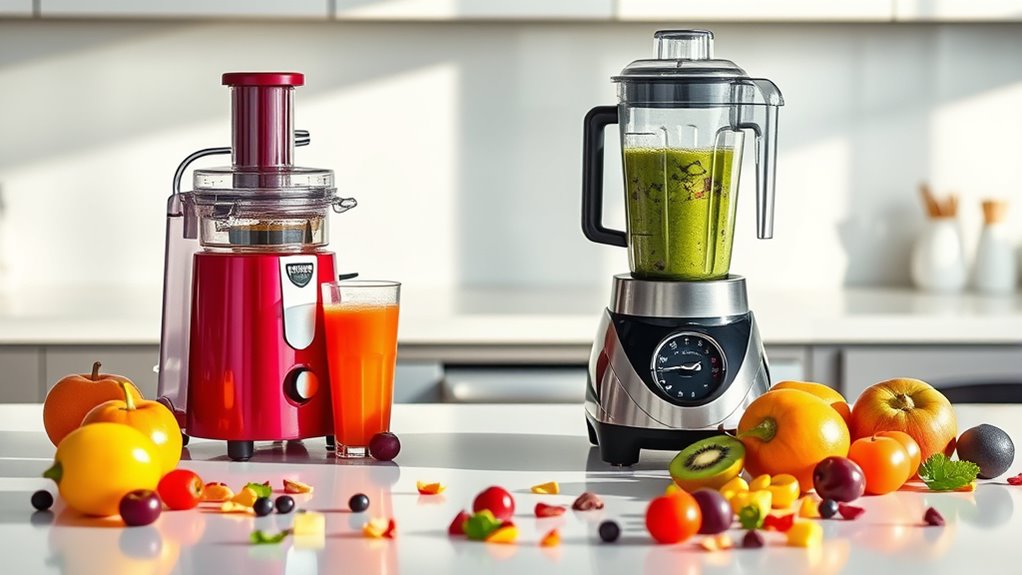
When you’re choosing equipment for juicing or blending, understanding the different types of juicers and blenders is essential. Investing in high-quality equipment can greatly impact the nutrient retention and overall quality of your drinks. For instance, using a cold press juicer can help retain more nutrients compared to other methods. Let’s explore what features to look for in both juicers and blenders to meet your nutritional goals.
Juicer Types Explained
Choosing the right juicer can greatly impact your experience and the quality of juice you produce. Here’s a quick overview of the main juicer types to help you decide:
| Juicer Type | Features | Best For |
|---|---|---|
| Masticating | Low speed, preserves enzymes and nutrients | Leafy greens, soft fruits |
| Centrifugal | High-speed blades, quick extraction | Hard fruits, quick juice |
| Twin Gear | High juice yield, excellent nutrient retention | All produce, nutrient-rich |
Each of these juicer types offers unique benefits. If nutrient retention and high juice yield are your priorities, masticating or twin gear juicers are your best bets. Additionally, consider incorporating chia seeds into your diet for added digestive health benefits. Remember, investing in quality equipment is key!
Blender Features Overview
A good blender can transform your kitchen experience, making it easier to whip up nutritious meals and snacks.
When choosing a blender, go for high-quality models like Vitamix or NutriBullet, designed to effectively blend whole fruits and veggies while preserving their nutrients.
Look for powerful motors with at least 1,000 watts to handle tough ingredients without overheating.
Blender versatility is key, so select one with multiple speed settings and pre-programmed functions for smoothies, soups, and sauces.
A larger capacity, ideally 64 ounces or more, is perfect for family servings or meal prep.
Finally, opt for easy-to-clean components, like dishwasher-safe parts, to streamline your routine and encourage regular use. Additionally, consider investing in a budget-friendly home appliance maintenance plan to keep your blender in optimal condition and extend its lifespan.
Investment in Quality Equipment
Investing in quality equipment can make a significant difference in your juicing and blending experience, ensuring you get the most out of your fruits and vegetables.
A high-quality juicer, especially a premium cold-press model, enhances juice extraction efficiency and nutrient retention. Unlike cheaper models, these juicers preserve essential enzymes thanks to their gentle extraction process.
When it comes to blending, choose a blender that doesn’t heat up during operation. Excessive heat can degrade nutrients and enzymes, compromising your health goals.
This investment in quality equipment not only encourages regular consumption of produce but also maximizes nutritional benefits. Additionally, using essential oils during your juicing or blending routine can enhance flavor and provide added health benefits.
Understanding the advantages of both juicing vs. blending will help you select the best tools to suit your dietary needs.
Making the Right Choice for Your Health
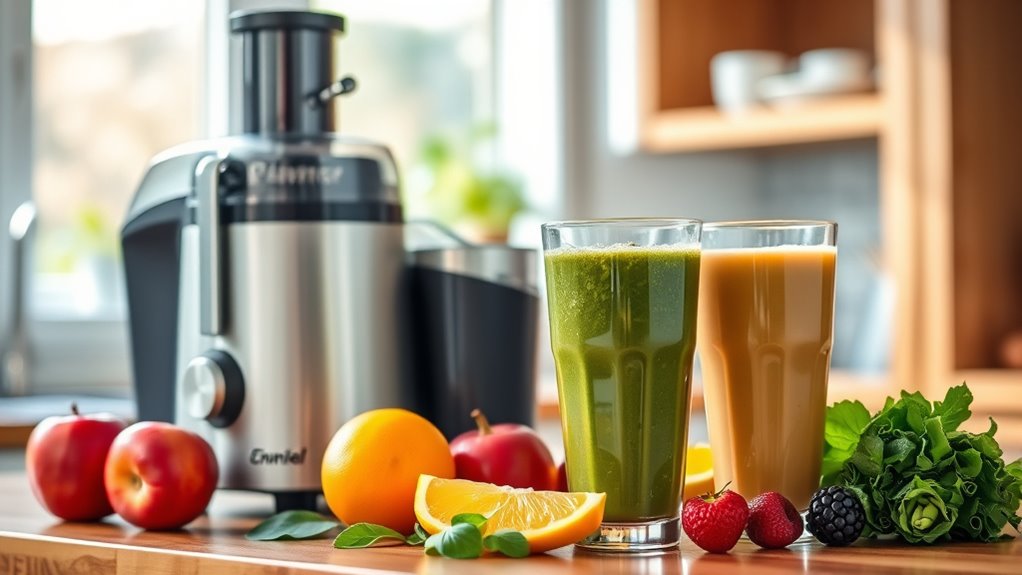
When it comes to enhancing your health, understanding the differences between juicing and blending can make a significant impact on your wellness journey.
Juicing extracts concentrated nutrients, offering quick energy boosts and detox benefits, but it can spike your blood sugar due to the loss of fiber.
Juicing delivers powerful nutrients for quick energy and detox, but may raise blood sugar levels due to fiber loss.
In contrast, blending retains fiber, promoting digestive health and keeping you fuller longer, which is beneficial for weight loss and stable blood sugar levels.
If your goal is rapid nutrient absorption and hydration, juicing might be your best bet.
However, if you want to enjoy whole food benefits and maintain balanced nutrition, blending is ideal.
Additionally, incorporating more raw fruits and vegetables into your diet can enhance nutrient retention and overall health benefits.
Ultimately, choose the method that aligns best with your personal health goals.
Frequently Asked Questions
Which Is Better for You Blending or Juicing?
When deciding whether blending or juicing is better for you, consider your health goals.
If you’re after quick nutrient absorption and hydration, juicing might be your go-to.
However, if you want to feel fuller longer and enjoy the benefits of fiber, blending is the way to go.
Both methods boost your fruit and vegetable intake, so think about what aligns with your preferences and lifestyle for ideal health benefits.
What Is One Downside About Juicing?
Imagine sipping sunshine in a glass—refreshing but deceptive. One major downside of juicing is that it strips away the essential insoluble fiber found in fruits and vegetables.
Without this fiber, your digestion may start to feel like a bumpy road. Plus, those sugary liquids can send your blood sugar levels soaring, leaving you crashing down soon after.
If you’re not careful, you might find yourself missing out on crucial nutrients and feeling unbalanced.
Is Drinking Juice Better Than Having a Fruit True or False?
It’s false that drinking juice is better than having whole fruit.
While juice offers a quick burst of vitamins, it lacks the fiber that helps stabilize your blood sugar. Whole fruits provide essential nutrients and phytonutrients often lost in the juicing process.
If you want ideal health, sticking to whole fruits is a smarter choice. They keep you fuller longer and support better digestive health without the sugar spike that juice can cause.
Is Juicing Scientifically Proven?
Juicing is like a quick burst of sunshine for your body, delivering nutrients at lightning speed. Yes, it’s scientifically proven to extract vitamins and minerals efficiently.
However, while it offers hydration and concentrated nutrients, it lacks the fiber that helps keep your digestion on track.
Conclusion
In the end, whether you choose juicing or blending, both can be powerful tools for your health. Think of them like two sides of the same coin—each offering unique benefits. Juicing gives you concentrated nutrients, while blending retains fiber for better digestion. Ultimately, it’s about what fits into your lifestyle and goals. So, experiment with both and see how each can enhance your wellness journey. Your body will thank you for it!
Cindy thoroughly researches juicing trends, techniques, and recipes to provide readers with practical advice and inspiration. Her writing style is accessible, engaging, and designed to make complex concepts easy to understand. Cindy’s dedication to promoting the advantages of juicing shines through her work, empowering readers to make positive changes in their lives through the simple act of juicing.

